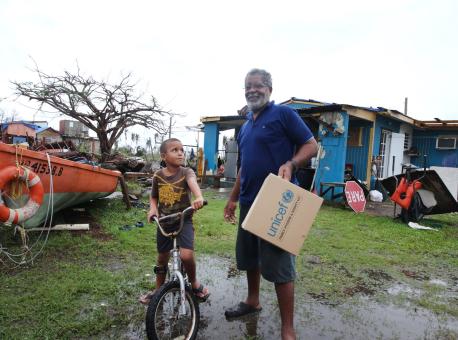
How It Feels to Help — and Keep Helping — Puerto Rico Build Back
Since Hurricane Maria hit Puerto Rico, UNICEF USA has been pitching in to get supplies to the most vulnerable. A UNICEF USA staffer gives a personal account of the ongoing relief work.
UNICEF USA Senior Officer, Humanitarian Emergencies and Executive Communications Michelle Centeno has been spending time in Puerto Rico, where UNICEF USA is working with UPS and New York Governor Andrew Cuomo's Empire State Relief and Recovery Effort for Puerto Rico to deliver emergency supplies. Here she gives her personal account of working with UNICEF USA to make a difference. And this week Michelle is back in Puerto Rico lending a hand before the holidays to a community that remains in need of support.
Our UNICEF USA crew flew into San Juan in the pouring rain. It had been a few weeks since Hurricane Maria had ravaged the entire island of Puerto Rico, and it was the remote areas that were hurting the most. UNICEF USA was working with local groups to set up distribution centers to provide people with the supplies they desperately needed, like safe drinking water and hygiene essentials. It was reassuring to be connected with highly respected, well-run organizations that are deeply invested in their communities, and use data and intelligence to make sure no one gets overlooked.
Major flooding after Hurricane Maria had left large sections of Puerto Rico underwater. Millions were still without power or water. UNICEF USA moved quickly to get supplies to the most vulnerable.
Under normal conditions, the drive from San Juan to Humacao, on Puerto Rico's southeast coast, would take about 45 minutes. It took us nearly three hours. Road conditions were terrible, with debris and pools of water blocking access. This highlights the challenges most folks face in trying to access relief and assistance from the mainland.
The hygiene kits we were delivering contain essential items to help people survive their current situation: buckets, soap, water purification tablets. Even if you were to wait in line to get inside a store, they were typically out of these supplies.
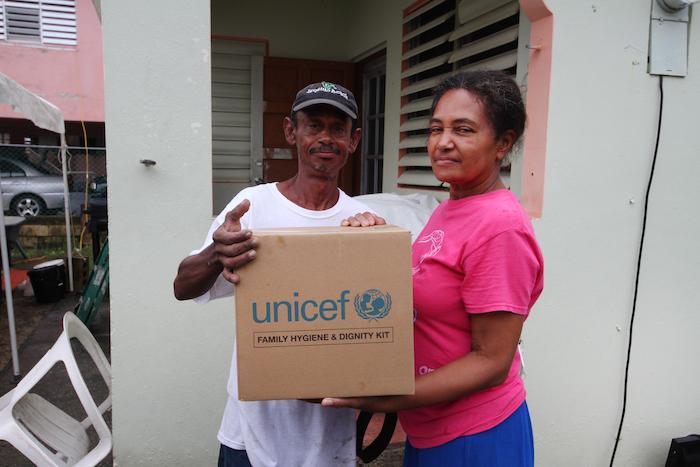
Maria Cruz, right, from community partner P.E.C.E.S., delivers a UNICEF hygiene kit to Luis Espinosa in Humacao, Puerto Rico.
The ongoing rainy season was making living conditions even worse. People had rigged up tarps to stay dry inside their damaged homes, but every time it rained, the makeshift shelters got soaked and fell apart again.
People were improvising livelihoods as best they could. We met one woman who said she had been hand washing her clothes and then hanging them up to dry on a pole that fell through her roof during the storm. She was so happy to open the box from UNICEF USA and find a clothesline and clothespins.
The fact that someone is thinking about them, their needs, and in particular their dignity, meant so much — continues to mean so much — to Puerto Ricans.
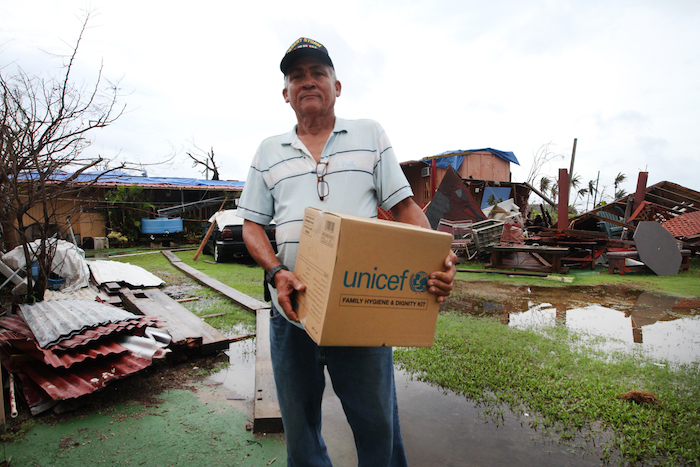
Gulf War veteran Rafael Torres's home was severely damaged by Hurricane Maria. Heavy rains have left his yard underwater; he used wooden planks to create a walkway connecting his house to the road.
Reaching homes to deliver hygiene kits was a challenge: we walked over rubble and through puddles of contaminated water.
We delivered a kit to Rafael Torres. Like most of the people we met, his house was severely damaged by the storm and he was living without electricity or running water. Heavy rains had turned his yard into a moat; he used wooden planks to create a walkway connecting his front door to the road. His entire living room had been destroyed and the remnants, including his sofa and coffee table, lay exposed in the yard. Torres is a Gulf War veteran; he said he never expected he'd be in a position where he'd be the one to need help. He was happy to receive a box from UNICEF USA.
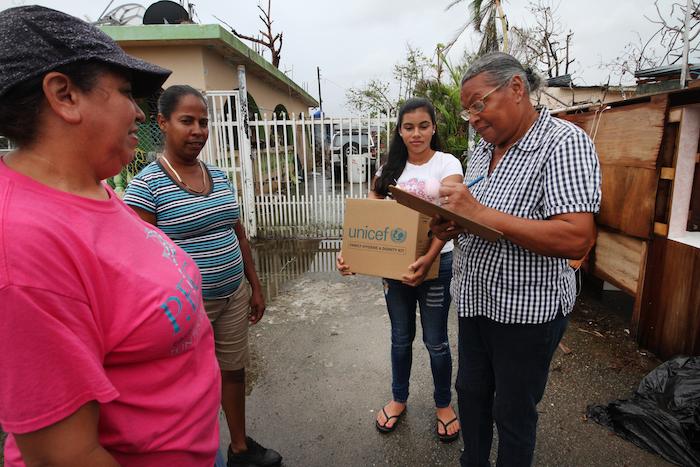
Adilesli Rodriguez and Gloribel Ortiz, left, from local community organization P.E.C.E.S., deliver a UNICEF hygiene kit to Elsa Martinez and Nadeisha Rivera, residents of Humacao.
People were really battered in Humacao. There was no cellphone or internet access, so after the storm, they couldn't reach their relatives to tell them they had survived. They were cut off from the rest of the world. Communities had to organize in a grassroots way in order to communicate.
Despite the destruction and devastation, we were able to experience firsthand the sense of community and willingness of people to come together and help one another, even if they themselves had lost everything. We heard plenty of stories about how seeing UNICEF USA in their communities was heartwarming. They never thought we would be there to help them: they usually donate and mobilize to help UNICEF help kids around the world.
She was so happy to open the box from UNICEF USA and find a clothesline and clothespins. The fact that someone is thinking about them, their needs, and in particular their dignity, means so much to Puerto Ricans now.
These lovely, resilient people remained hopeful and that was truly inspiring. They even offered their support with anything UNICEF might need help with; they know that there are other kids around the world who have needs.
I never got the chance to visit Puerto Rico before the hurricane, but I always heard the island is beautiful. And now I have learned firsthand that the people who live there are, too. I'm back in Puerto Rico this week delivering more supplies, and I couldn't be more honored to be doing this work.
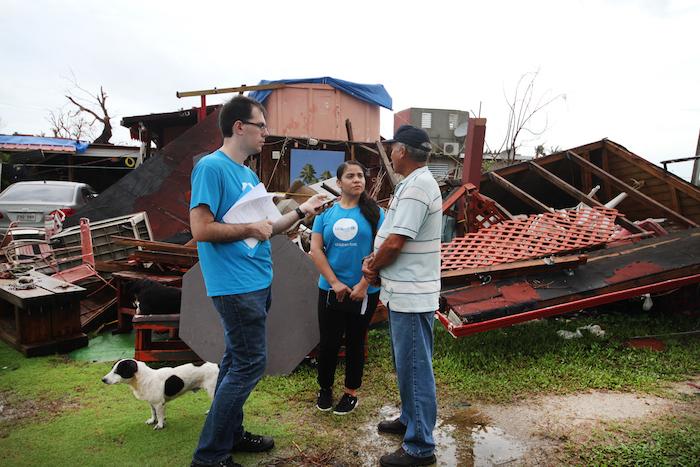
UNICEF USA's Michelle Centeno and Justin Hemenway visited Rafael Torres outside his damaged house in Humacao, Puerto Rico.
Banner photo at top: Kendall Ortiz and Damian Orta in storm-damaged Humacao, Puerto Rico. All photos by Paola Isabel Hernandez for UNICEF USA.
HOW TO HELP
There are many ways to make a difference
War, famine, poverty, natural disasters — threats to the world's children keep coming. But UNICEF won't stop working to keep children healthy and safe.
UNICEF works in over 190 countries and territories — more places than any other children's organization. UNICEF has the world's largest humanitarian warehouse and, when disaster strikes, can get supplies almost anywhere within 72 hours. Constantly innovating, always advocating for a better world for children, UNICEF works to ensure that every child can grow up healthy, educated, protected and respected.
Would you like to help give all children the opportunity to reach their full potential? There are many ways to get involved.



